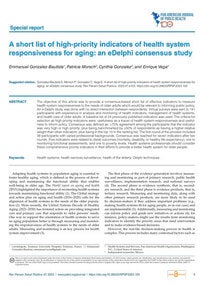Gonzalez-Bautista et al.
The objective of this article was to provide a consensus-based short list of effective indicators to measure health system responsiveness to the needs of older adults which would be relevant to informing public policy. An e-Delphi study was done with no direct interaction between respondents. Virtual surveys were sent to 141 participants with experience in analysis and monitoring of health indicators, management of health systems, and health care of older adults. A baseline list of 24 previously published indicators was used. The criteria for selection as high priority indicators were: usefulness as a tracer of health system responsiveness and usefulness to inform policy. Consensus was defined as: ≥70% agreement among the participants that the indicator was very high or high priority; plus being benchmarked by ≥50% of respondents as having a higher relative weight than other indicators; plus being in the top 10 in the ranking list. The first round of the process included 38 participants with varied professional backgrounds. Consensus was reached for seven indicators after two rounds. Five indicators were related to distal outcomes (mortality, disability, or healthy life expectancy), one to monitoring functional assessments, and one to poverty levels. Health systems professionals should consider these comprehensive priority indicators in their efforts to provide a better health system for older people.
|

